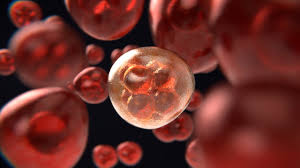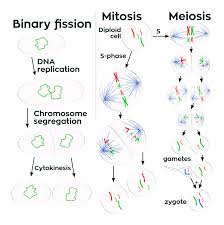- What is the cell division and reproducation?
Cell division and reproduction are fundamental biological processes that occur in living organisms.
Cell Division,
Cell division is the process by which a cell divides into two or more daughter cells. There are two main types of cell division:
| 1. Mitosis | A type of cell division that results in two daughter cells that are genetically identical to the parent cell. Mitosis is essential for growth, repair, and maintenance of tissues. |
| 2. Meiosis: | A type of cell division that occurs in reproductive cells, resulting in four daughter cells that are genetically unique and contain half the number of chromosomes as the parent cell. Meiosis is essential for sexual reproduction. |
Cell Reproduction,
Cell reproduction refers to the process by which cells produce new cells. This can occur through:
| 1. Asexual reproduction | A type of reproduction where an organism produces offspring that are genetically identical to itself. |
| 2. Sexual reproduction | A type of reproduction where two parents contribute genetic material to produce offspring that are genetically unique. |
Importance of Cell Division and Reproduction
Cell division and reproduction are crucial for:
1. Growth and development: Cell division allows organisms to grow and develop.
2. Tissue repair: Cell division helps repair damaged tissues.
3. Reproduction: Cell division and reproduction enable organisms to produce offspring.
4. Evolution: Cell division and reproduction introduce genetic variation, which drives evolution.
In summary, cell division and reproduction are essential processes that occur in living organisms, enabling growth, repair, and reproduction.
- What is the summary of cell division ?
Cell division is the process by which a cell divides into two or more daughter cells. There are two main types:
1. Mitosis: Produces two identical daughter cells for growth, repair, and maintenance.
2. Meiosis: Produces four unique daughter cells with half the chromosomes for sexual reproduction.
Key Points
- Cell division is essential for growth, repair, and reproduction.
- Mitosis produces genetically identical cells.
- Meiosis produces genetically unique cells.
Importance
- Enables growth and development
- Repairs damaged tissues
- Allows for reproduction and genetic diversity
Cell division is a fundamental process that occurs in all living organisms, and understanding it is crucial for understanding life itself.
- What are the 4 stages of cell reproducation ?
The four stages of cell reproduction, specifically referring to the cell cycle, are:
The Cell Cycle,
| 1. G1 (Gap 1): | The cell grows, replicates organelles, and prepares for DNA replication. |
| 2. S (Synthesis) | DNA replication occurs, and the genetic material is duplicated. |
| 3. G2 (Gap 2): | The cell prepares for cell division, and organelles are replicated. |
| 4. M (Mitosis) | Cell division occurs, and the replicated DNA is divided equally between two daughter cells. |
These stages ensure that the new cells receive the correct amount of genetic material and organelles to function properly.
- What are the Different between cell division ans cell reproducation?
Cell division and cell reproduction are related but distinct processes. Here’s a brief overview of the differences:
Cell Division
Refers to the process of a cell dividing into two or more daughter cells.
- Involves the replication of DNA and the distribution of genetic material to daughter cells.
- Can occur through mitosis or meiosis.
 Cell Reproduction
Cell Reproduction
- Refers to the process of cells producing new cells, either through cell division or other mechanisms.
- Encompasses both cell division and other forms of cell reproduction, such as budding or fragmentation.
- Can result in the production of genetically identical or genetically unique cells.
Key Differences
- Scope: Cell division is a specific process, while cell reproduction is a broader term that encompasses multiple processes.
- Mechanisms: Cell division typically involves mitosis or meiosis, while cell reproduction can involve various mechanisms, such as budding, fragmentation, or regeneration.
- Outcome: Cell division results in the production of new cells, while cell reproduction can result in the production of new cells, tissues, or organisms.
In summary, cell division is a specific process that occurs within cells, while cell reproduction is a broader term that encompasses multiple processes and mechanisms.
Read more,
- What is Blinkit app?
- Rapido owner name?
- Thailand prime minister name ?
- Switzerland Famous for?
- Summer Season month name ?